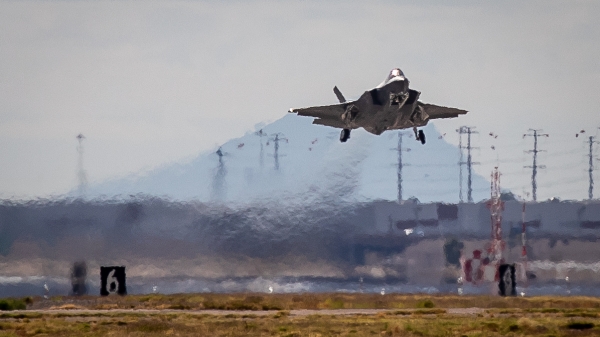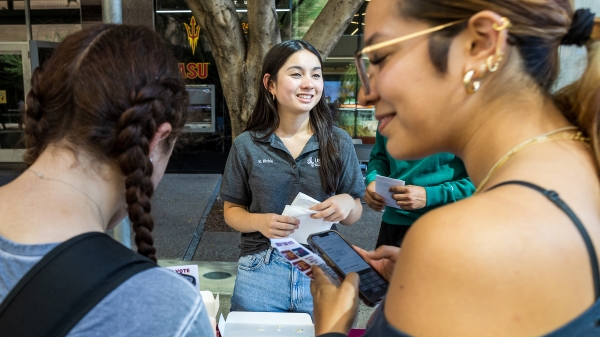Medical innovation without borders

Mia Armstrong, coordinator of ASU Convergence Lab, introduces Rafael Fonseca, Guillermo Torre Amione, Rodolfo Rubio Etcharren and Ana Julia Narvaez in a recent ASU Convergence Lab and Tecnológico de Monterrey event on cross-border medical innovation. Photo courtesy of Tecnológico de Monterrey
Mexico and the U.S. are connected by a constant flow of people, goods and investment across the 1,954-mile border they share and far beyond it. Less visible, but no less profound, is the exchange of ideas and innovation between the two countries, particularly in science and medical fields.
In a recent ASU Convergence Lab and Tecnológico de Monterrey event, experts considered how to expand and amplify that exchange for the good of the region.
“One of the great teachings brought by the current pandemic was that when we talk about science, we’re talking about a world without borders,” said Guillermo Torre Amione, rector of TecSalud and vice president of research at the Tecnológico de Monterrey.
While it can be hard to measure the flow of innovation and ideas across borders, we can measure the flow of students: During the 2018–19 school year, 15,229 Mexican students studied in the U.S., and 6,340 U.S. students studied in Mexico, according to the Institute of International Education. In 2019, Mexico was ranked 14th among countries of origin for temporary visa holders earning U.S. doctorates, with 188 doctorate earners, according to the National Science Foundation.
Importantly, 64.4% of those doctorate earners indicated they intended to stay in the U.S. upon graduation, painting a picture of the phenomenon known as “brain drain,” or human capital flight, where large numbers of highly trained or educated individuals migrate away from their home countries to work or study and often don’t return.
The impacts of brain drain are complex and debated. On the one hand, people argue that the countries suffering from brain drain need their best and brightest at home to spur further development. On the other, some point out, many countries of origin don’t have the infrastructure for highly qualified researchers to do the work they end up doing abroad — work that ultimately benefits their home countries.
Take, for example, the case of Ana Julia Narvaez, one of the speakers at the event and the director of biological science and translational biology at Moderna, where she worked on the development of the company’s COVID-19 vaccine. Narvaez moved to the U.S. to earn her PhD in biochemistry after completing her undergraduate degree at the Tec, a move largely motivated by her desire to do in-depth biological research, she said.
After graduating from Arizona State University, she completed postdoctoral research at Stockholm University in Sweden, then worked as a research associate at the University of Cambridge, and finally as an associate principal scientist at AstraZeneca, also in Cambridge. While she hasn't returned to Mexico, there’s no question that the benefits of her research at Moderna cross borders.
For Narvaez, the solution to the brain drain problem in Mexico lies with more support for research.
“You have to see it as an investment, and not as a cost,” she said. “And you have to look at it long-term.”
Narvaez said she learned a lot from the European model, where large numbers of researchers leave their countries temporarily to study or work, but later receive support to return home.
For Dr. Rafael Fonseca, director of innovation and transformational relationships at Mayo Clinic, the question surrounding the brain drain debate — where can researchers do the most good — is an “existential” one.
“Home always calls to us,” said Fonseca, who studied his medical degree at the Universidad Anáhuac in Mexico City before moving to the U.S. to complete his residency, fellowship and begin a successful medical and research career.
“(Brain drain is) a problem solved by opportunities, it’s a problem solved by infrastructure that allows research to be carried out, it’s a problem solved by the funding behind all these projects … with a strong private sector,” he said.
Similarly, Torre Amione studied and worked in the U.S. for more than 25 years before returning to Mexico. For him, creating more opportunities for groundbreaking medical and scientific research is “a political matter; it’s a matter of a country’s strategy.”
The speakers agreed that expanding the exchange of students, researchers, and ideas between Mexico and the U.S. should be a priority.
“It’s so important to design processes and paths that facilitate the flow of talent,” said Rodolfo Rubio Etcharren, vice president of communication and relationships at the Tec and the conversation’s moderator. Relationships between institutions in different countries should be built and maintained deliberately, he said, in a way that ensures the exchange of talent and innovation is significant and sustainable.
We’re in a moment of great change in scientific and medical fields, the experts highlighted. For one, the practice of health care, and the technology used to do it, are constantly shifting — especially with the popularization of telemedicine — and thus posing big questions about the best way to teach future health care providers. To address those questions, ASU and Mayo Clinic launched the Mayo Clinic and Arizona State University Alliance for Health Care.
“My advice (to students) is to focus on studies related to artificial intelligence, machine learning, and other specialties that aren’t just necessary, but indispensable,” said Fonseca, one of the leaders of the Mayo Clinic and ASU Alliance for Health Care and a myeloma specialist, who recalled recently seeing patients in Chile, Mexico City, Bulgaria and New Mexico all in the same day.
The pandemic has also underscored the need for a cross-disciplinary, cross-institutional and cross-border approach to research, the speakers emphasized.
“I think we’ve learned that we can’t do it alone,” Narvaez said. “(We’re) not where we need to be, definitely not, but I think there’s a little more self awareness that we have to be a little more open, and we have to share a little more, at least at the level of individual institutions.”
Torre Amione said he hopes the devastation wrought by the pandemic in Mexico will recatalyze efforts to overhaul the country’s health system, focusing on improving care and prevention.
“Information will flow more, there will be more access to digital information, doctors and patients are going to have better channels of communication,” he said. “I think this is a detonator for change.”
View the full event here (in Spanish).
Written by Mia Armstrong, ASU Convergence Lab.
More Local, national and global affairs

Thunderbird at ASU, AUK student appointed as Ukraine’s deputy minister of education and science
Nadiia Kuzmychova, a student in the Master of Leadership and Management (MLM) program at Thunderbird School of Global…

ASU creates pathways to public service careers for military students
The School of Public Affairs at Arizona State University is making careers in public service easier to access for military…

Minting community leaders and stellar citizens: ASU’s Public Service Academy approaches 10-year milestone
Airports that are easier to navigate.Health care that is simple to access.Helping underrepresented youth reach college.These are…